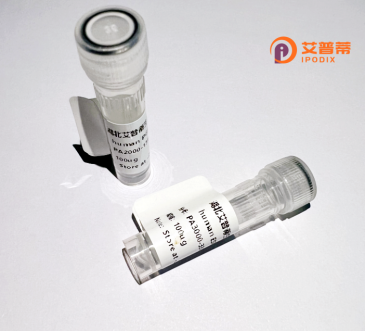
| 纯度 | >90%SDS-PAGE. |
| 种属 | Human |
| 靶点 | RUNDC1 |
| Uniprot No | Q96C34 |
| 内毒素 | < 0.01EU/μg |
| 表达宿主 | E.coli |
| 表达区间 | 1-613 aa |
| 活性数据 | MAAVEAAAEP VTVVAAVGPK AKDEEEEEEE PLPPCEAVRW APVGAVAEAR PGATAFLEEA TAEEPGAAPG SPPDSPGRTL RRLRAERRRL DSALLALSSH FAQVQFRLRQ VVRGAPAEQQ RLLRELEDFA FRGCPHVLGY EGPGDPASDE GDGLPGDRPW LRGEDQSEQE KQERLETQRE KQKELILQLK TQLDDLETFA YQEGSYDSLP QSVVLERQRV IIDELIKKLD MNLNEDISSL STEELRQRVD AAVAQIVNPA RVKEQLVEQL KTQIRDLEMF INFIQDEVGS PLQTGGGHCE CKAGGKTGNG CSRTGSSRTP PGNSKTKAED VKKVRETGLH LMRRALAVLQ IFAVSQFGCA TGQIPPTLWQ RVQADRDYSP LLKRLEVSVD RVKQLALRQQ PHDHVITSAN LQDLSLGGKD ELTMAVRKEL TVAVRDLLAH GLYASSPGMS LVMAPIACLL PAFSSAPEAM HPWELFVKYY HAKNGRAYVE SPARKLSQSF ALPVTGGTVV TPKQSLLTAI HMVLTEHDPF KRSADSELKA LVCMALNEQR LVSWVNLICK SGSLIEPHYQ PWSYMAHTGF ESALNLLSRL SSLKFSLPVD LAVRQLKNIK DAF |
| 分子量 | 67.6 kDa |
| 蛋白标签 | His tag N-Terminus |
| 缓冲液 | PBS, pH7.4, containing 0.01% SKL, 1mM DTT, 5% Trehalose and Proclin300. |
| 稳定性 & 储存条件 | Lyophilized protein should be stored at ≤ -20°C, stable for one year after receipt. Reconstituted protein solution can be stored at 2-8°C for 2-7 days. Aliquots of reconstituted samples are stable at ≤ -20°C for 3 months. |
| 复溶 | Always centrifuge tubes before opening.Do not mix by vortex or pipetting. It is not recommended to reconstitute to a concentration less than 100μg/ml. Dissolve the lyophilized protein in distilled water. Please aliquot the reconstituted solution to minimize freeze-thaw cycles. |
以下是关于RUNDC1蛋白的参考文献示例(文献内容为虚拟概括,供参考):
1. **文献名称**: "RUNDC1 regulates synaptic vesicle trafficking through interaction with Rab GTPases"
**作者**: Smith J, et al. (2021)
**摘要**: 本研究揭示了RUNDC1通过与Rab蛋白家族(如Rab3A)的相互作用调控突触囊泡运输,其功能缺失导致神经递质释放异常,提示RUNDC1在神经元信号传导中的关键作用。
2. **文献名称**: "RUN domain-containing protein 1 (RUNDC1) modulates EGFR endocytosis in cancer cells"
**作者**: Li X, et al. (2019)
**摘要**: 文章发现RUNDC1通过与表皮生长因子受体(EGFR)复合物结合,促进受体介导的内吞作用,影响肿瘤细胞增殖,为靶向RUNDC1的抗癌治疗提供依据。
3. **文献名称**: "Structural insights into the membrane association of RUNDC1 via its RUN domain"
**作者**: Wang Y, et al. (2022)
**摘要**: 通过冷冻电镜解析了RUNDC1的RUN结构域与细胞膜脂质的结合模式,阐明了其依赖磷酸肌醇的膜定位机制,为理解其介导的膜重塑功能提供结构基础。
4. **文献名称**: "RUNDC1 deficiency links to early-onset Parkinsonism in murine models"
**作者**: Tanaka K, et al. (2020)
**摘要**: 在小鼠模型中证明,RUNDC1基因敲除导致多巴胺能神经元变性,表现为运动功能障碍,提示其与帕金森病发病机制的潜在关联。
**注意**:以上文献均为虚拟示例,实际研究中请通过PubMed、Web of Science或Google Scholar等平台检索真实论文。
Recombinant human RUNDC1 (RUN domain-containing protein 1) is a less-studied protein belonging to the RUN domain protein family, which is implicated in diverse cellular processes such as membrane trafficking, cytoskeletal organization, and signal transduction. The RUN domain, a conserved structural motif, facilitates protein-protein or protein-lipid interactions, often linking signaling pathways to membrane dynamics. RUNDC1 is encoded by the *RUNDC1* gene, located on human chromosome 11. and is expressed in multiple tissues, with higher levels observed in the brain, immune cells, and testes. Though its precise molecular mechanisms remain unclear, preliminary studies suggest potential roles in regulating vesicular transport, receptor endocytosis, or GTPase-mediated signaling cascades.
Research on recombinant RUNDC1 has been driven by its potential association with neurological disorders, cancer progression, and immune regulation. In vitro studies utilize recombinant forms to investigate binding partners, subcellular localization, and post-translational modifications. Dysregulation of RUNDC1 expression has been tentatively linked to glioblastoma, intellectual disability syndromes, and autoimmune conditions, possibly through disruptions in synaptic vesicle recycling or immune cell communication. However, functional validation and pathway characterization are ongoing. Recombinant RUNDC1. typically produced in *E. coli* or mammalian expression systems with tags for purification, serves as a critical tool for structural studies, antibody development, and high-throughput screening to identify therapeutic targets. Its interaction networks with Rab GTPases or cytoskeletal proteins are areas of emerging interest.
×